Coordination of size and number of excitatory and inhibitory synapses results in a balanced structural plasticity along mature hippocampal CA1 dendrites during LTP
- PMID: 20101601
- PMCID: PMC2891364
- DOI: 10.1002/hipo.20768
Coordination of size and number of excitatory and inhibitory synapses results in a balanced structural plasticity along mature hippocampal CA1 dendrites during LTP
Abstract
Enlargement of dendritic spines and synapses correlates with enhanced synaptic strength during long-term potentiation (LTP), especially in immature hippocampal neurons. Less clear is the nature of this structural synaptic plasticity on mature hippocampal neurons, and nothing is known about the structural plasticity of inhibitory synapses during LTP. Here the timing and extent of structural synaptic plasticity and changes in local protein synthesis evidenced by polyribosomes were systematically evaluated at both excitatory and inhibitory synapses on CA1 dendrites from mature rats following induction of LTP with theta-burst stimulation (TBS). Recent work suggests dendritic segments can act as functional units of plasticity. To test whether structural synaptic plasticity is similarly coordinated, we reconstructed from serial section transmission electron microscopy all of the spines and synapses along representative dendritic segments receiving control stimulation or TBS-LTP. At 5 min after TBS, polyribosomes were elevated in large spines suggesting an initial burst of local protein synthesis, and by 2 h only those spines with further enlarged synapses contained polyribosomes. Rapid induction of synaptogenesis was evidenced by an elevation in asymmetric shaft synapses and stubby spines at 5 min and more nonsynaptic filopodia at 30 min. By 2 h, the smallest synaptic spines were markedly reduced in number. This synapse loss was perfectly counterbalanced by enlargement of the remaining excitatory synapses such that the summed synaptic surface area per length of dendritic segment was constant across time and conditions. Remarkably, the inhibitory synapses showed a parallel synaptic plasticity, also demonstrating a decrease in number perfectly counterbalanced by an increase in synaptic surface area. Thus, TBS-LTP triggered spinogenesis followed by loss of small excitatory and inhibitory synapses and a subsequent enlargement of the remaining synapses by 2 h. These data suggest that dendritic segments coordinate structural plasticity across multiple synapses and maintain a homeostatic balance of excitatory and inhibitory inputs through local protein-synthesis and selective capture or redistribution of dendritic resources.
Copyright © 2009 Wiley-Liss, Inc.
Figures
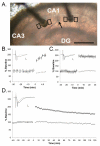

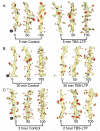


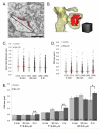

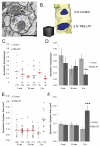
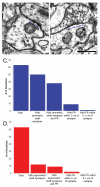
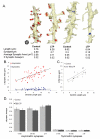

Similar articles
-
Shifting patterns of polyribosome accumulation at synapses over the course of hippocampal long-term potentiation.Hippocampus. 2018 Jun;28(6):416-430. doi: 10.1002/hipo.22841. Epub 2018 Apr 16. Hippocampus. 2018. PMID: 29575288 Free PMC article.
-
LTP enhances synaptogenesis in the developing hippocampus.Hippocampus. 2016 May;26(5):560-76. doi: 10.1002/hipo.22536. Epub 2015 Oct 23. Hippocampus. 2016. PMID: 26418237 Free PMC article.
-
Excitatory synaptic activity is associated with a rapid structural plasticity of inhibitory synapses on hippocampal CA1 pyramidal cells.Neuropharmacology. 2011 Apr;60(5):757-64. doi: 10.1016/j.neuropharm.2010.12.014. Epub 2010 Dec 25. Neuropharmacology. 2011. PMID: 21187106
-
Voltage Imaging in the Study of Hippocampal Circuit Function and Plasticity.Adv Exp Med Biol. 2015;859:197-211. doi: 10.1007/978-3-319-17641-3_8. Adv Exp Med Biol. 2015. PMID: 26238054 Review.
-
Balancing structure and function at hippocampal dendritic spines.Annu Rev Neurosci. 2008;31:47-67. doi: 10.1146/annurev.neuro.31.060407.125646. Annu Rev Neurosci. 2008. PMID: 18284372 Free PMC article. Review.
Cited by
-
BDNF-dependent nano-organization of Neogenin and the WAVE regulatory complex promotes actin remodeling in dendritic spines.iScience. 2024 Jul 30;27(9):110621. doi: 10.1016/j.isci.2024.110621. eCollection 2024 Sep 20. iScience. 2024. PMID: 39228790 Free PMC article.
-
Large-volume reconstruction of brain tissue from high-resolution serial section images acquired by SEM-based scanning transmission electron microscopy.Methods Mol Biol. 2013;950:253-73. doi: 10.1007/978-1-62703-137-0_15. Methods Mol Biol. 2013. PMID: 23086880 Free PMC article.
-
Effects of homeostatic constraints on associative memory storage and synaptic connectivity of cortical circuits.Front Comput Neurosci. 2015 Jun 18;9:74. doi: 10.3389/fncom.2015.00074. eCollection 2015. Front Comput Neurosci. 2015. PMID: 26150784 Free PMC article.
-
Three-Dimensional Synaptic Organization of Layer III of the Human Temporal Neocortex.Cereb Cortex. 2021 Aug 26;31(10):4742-4764. doi: 10.1093/cercor/bhab120. Cereb Cortex. 2021. PMID: 33999122 Free PMC article.
-
Rapid effects on memory consolidation and spine morphology by estradiol in female and male rodents.Horm Behav. 2018 Aug;104:111-118. doi: 10.1016/j.yhbeh.2018.04.007. Epub 2018 May 31. Horm Behav. 2018. PMID: 29669258 Free PMC article. Review.
References
-
- Aakalu G, Smith WB, Nguyen N, Jiang C, Schuman EM. Dynamic visualization of local protein synthesis in hippocampal neurons. Neuron. 2001;30:489–502. - PubMed
-
- Abraham WC, Huggett A. Induction and reversal of long-term potentiation by repeated high- frequency stimulation in rat hippocampal slices. Hippocampus. 1997;7:137–145. - PubMed
-
- Bliss TVP, Collingridge GL. A synaptic model of memory: long-term potentiation in the hippocampus. Nature. 1993;361:31–39. - PubMed
-
- Bourne J, Harris KM. Do thin spines learn to be mushroom spines that remember? Curr. Opin. Neurobiol. 2007;17:381–386. - PubMed
Publication types
MeSH terms
Grants and funding
LinkOut - more resources
Full Text Sources
Miscellaneous

